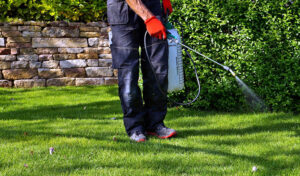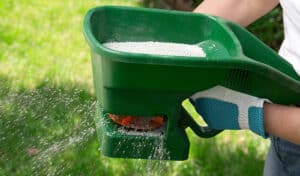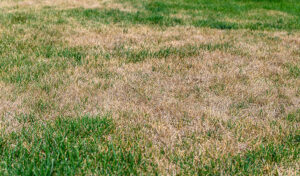With its frosty charm, winter often leaves behind a landscape yearning for revival — a problem that spring lawn care resolves.
As homeowners, the spring season beckons us to don our gardening gloves and breathe new life into our lawns. This rejuvenation nurtures a vital part of our home’s natural environment.
This comprehensive guide delves into the essential steps to wake your lawn from its winter slumber. From assessing the toll of the cold months to implementing the best practices for spring lawn care, we’ll equip you with the knowledge and techniques to ensure your lawn emerges lush, vibrant, and full of life.
Get ready to transform your lawn into a thriving green oasis as we journey through the essentials of post-winter lawn care in Utah.

Understanding how Utah winters affect lawns
Utah’s winters are characterized by cold temperatures, snowfall, and varying climate conditions, which significantly impact lawn health. Here’s how Utah winters typically affect lawns:
Dormancy
Most grass types in Utah enter a dormant state during winter. While dormancy is a natural protective mechanism, it leaves lawns looking brown and lifeless. As unpleasant as it looks, it’s necessary for the grass to conserve energy and survive the cold.
Frost and ice damage
Frost and ice cause physical damage to grass blades. Repeated freezing and thawing can damage or kill the grass’s roots, especially if the lawn is not well-prepared for winter.
Snow mold
In areas with prolonged snow cover, lawns might develop snow mold. This fungal disease appears as circular patches of dead or dying grass and is usually found when snow melts.
Dehydration
Despite the presence of snow and ice, lawns can still suffer from dehydration in winter. Cold, dry winds and the inability of frozen soil to absorb moisture contribute to this problem.
Soil compaction
Heavy snowfall and foot traffic on the lawn will likely lead to soil compaction. Compacted soil restricts root growth, reduces air and nutrient penetration, and impedes water drainage, all of which are detrimental to grass health.
Rodent damage
Rodents like voles can cause damage to lawns in winter by creating runways and burrows through the soil and the grass’s root system. This activity leaves visible trails of destruction across the lawn.
Chemical damage
The use of de-icing salts on nearby driveways and walkways leads to salt accumulating in the soil. This buildup harms the grass and affects its ability to absorb water and nutrients.
Given these challenges, lawns in Utah require specific care as winter recedes to ensure a healthy recovery and transition into spring. That’s why it’s important to assess your lawn for damage and use the right strategies to revive and maintain your lawn during the spring months.
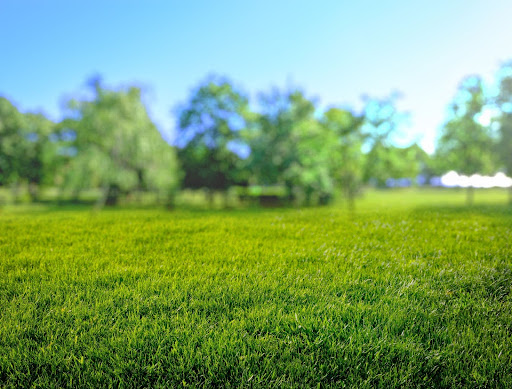
Your lawn: an initial assessment
As winter in Utah wanes and signs of spring emerge, early spring lawn care becomes essential. It’s important to conduct an initial assessment of your lawn to determine its condition and plan for revival. Here’s a step-by-step approach to effectively assess your lawn:
- Wait for the right time: Begin your assessment when the majority of the snow has melted and the soil isn’t overly wet or frozen. Walking on soggy or frozen grass might cause further damage.
- Conduct a visual inspection: Start with a general visual inspection. Look for any uneven coloring, bare spots, areas of matted grass, or visible signs of disease.
Notice if there are areas with excessive thatch — a layer of dead grass and organic matter that impedes water and nutrient penetration. - Check for compaction: Test for soil compaction by trying to insert a screwdriver or garden fork into the soil. If it’s difficult to penetrate, the soil may be compacted. Compacted areas, often found in high-traffic zones, need aeration to improve air, water, and nutrient flow.
- Identify weed and pest problems: Look for early signs of weed growth or pest activity. Winter weeds or evidence of rodents, like burrowing or grass damage, indicate areas that need specific attention.
- Assess moisture levels: Check the soil’s moisture level. Dry soil is a sign that your lawn is dehydrated, whereas overly wet soil may indicate drainage issues.
- Evaluate grass health: Gently rake a few areas to see how well the grass blades are attached. If they come off easily, it could indicate a problem like disease or poor root health. Determine the overall density of the grass and note any thin or bare areas that may need overseeding.
- Examine thatch layer: Assess the thatch layer. If it’s thicker than ½ inch, dethatching might be necessary.
- Note any salt damage: If your lawn is adjacent to roads or paths where salt was used for de-icing, look for signs of salt damage, which often manifests as discolored or dead patches.
- Plan for treatment: Based on your assessment, plan for the necessary treatments, which could include aeration, dethatching, overseeding, fertilization, weed control, and pest management.
Once you’ve evaluated your lawn’s health, it’s time for early spring lawn care.
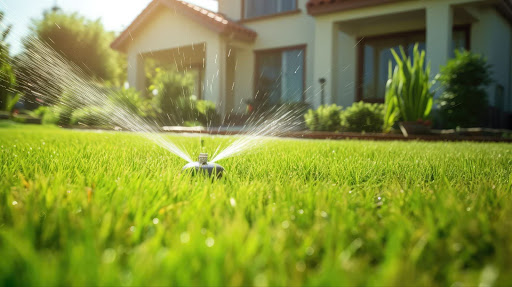
Essential spring lawn care tasks
As spring arrives, attending to early spring lawn care will help promote healthy growth and recover from winter stress. Here are key tasks essential for spring lawn care:
Cleaning and clearing
Begin with removing debris, such as fallen branches, leaves, and trash that may have accumulated over winter. Doing this prevents mold growth and ensures that your lawn can breathe and receive sunlight evenly.
Mowing
Start mowing as the grass begins to grow. Keep the blades high initially to avoid cutting the grass too short. Proper mowing stimulates growth and helps in achieving a denser and healthier lawn.
Aeration
Aerating the lawn involves making holes in the soil either by a machine aerator or a manual tool. Aeration relieves soil compaction, allowing air, water, and nutrients to penetrate the root zone more effectively.
Dethatching
Remove thatch with a dethatching rake or machine to prevent waterlogging and disease and to ensure nutrients reach the soil.
Overseeding
Spread grass seed evenly over your lawn, particularly in bare or thinning areas. Overseeding helps to create a thick, lush lawn, discourages weeds, and improves the lawn’s overall health and appearance.
Fertilizing
Apply a spring lawn fertilizer according to the grass type and soil test recommendations. Fertilization provides essential nutrients supporting root growth and lawn vigor after the dormant winter period.
Weed control
Apply pre-emergent herbicides to prevent weed seeds from germinating and post-emergent herbicides for visible weeds. Early weed control prevents weeds from competing with grass for nutrients and sunlight.
Watering
Begin regular watering as the weather warms and the lawn’s water requirements increase. You need to water enough that the grass stays healthy, especially as new seeds are germinating.
Pest and disease inspection
Regularly inspect your lawn for signs of pests or disease. The earlier you catch it, the more likely you are to prevent widespread lawn damage.
Edge trimming
Trim edges along driveways, walkways, and garden beds. Edging makes the lawn neat and defines the boundary between the lawn and other areas.
Mowing practices for lawn health
Proper mowing is an important part of spring lawn care, as it helps maintain the health and vitality of your lawn. Here are some tips to keep your lawn as healthy as possible.
- Mowing at the right height: Different grass types have optimal mowing heights. Generally, cutting grass to a height of about 2-3 inches is ideal for most types. Avoid cutting more than one-third of the grass blade length at a time to prevent stress and damage to the grass.
- Use sharp blades: Sharpen mower blades regularly. Dull blades tear the grass, leading to a ragged edge that makes the lawn more susceptible to diseases and pests. Sharp blades ensure a clean cut, which is healthier for the grass and gives the lawn a smoother appearance.
- Mow when the grass is dry: Mow the lawn when the grass is dry. Wet grass can clump and not cut evenly; mowing wet grass also spreads diseases.
- Change mowing patterns: Alternate your mowing patterns each time you mow. This prevents the grass from bending in one direction and reduces soil compaction. Varying the pattern also ensures an even cut and reduces wear and tear on the lawn.
- Adjust mowing frequency: Mow based on the growth rate of the grass, not on a fixed schedule. During peak growing seasons, you may need to mow more frequently. During slower growth periods, reduce the mowing frequency to avoid stressing the grass.
- Leave grass clippings: Consider leaving the grass clippings on the lawn (known as grasscycling) unless they are excessively thick. Clippings decompose and return valuable nutrients to the soil, acting as a natural fertilizer.
Spring lawn care with Summit Lawn & Pest Control
Ready to leave winter behind and embrace a lush, vibrant lawn this spring? At Summit Lawn & Pest Control, we’re here to make that transition seamless and successful. With the unique challenges of Utah’s climate, your lawn requires knowledgeable care and attention to truly flourish. That’s where we come in.
Our team of experts is equipped with the tools, expertise, and passion needed to revitalize your lawn. From thorough assessments to customized treatments, we cover every aspect of spring lawn care.
Whether it’s aeration, fertilization, weed control, or pest management, our services are designed to meet the specific needs of your lawn, ensuring it recovers from winter and thrives throughout the year.
Don’t let winter’s aftermath dampen your outdoor space’s beauty. Contact Summit Lawn & Pest Control today and take the first step towards a healthier, more beautiful lawn this spring. Together, we’ll create a lush, inviting landscape that you and your family will enjoy all season long. Let’s bring your lawn back to life!



